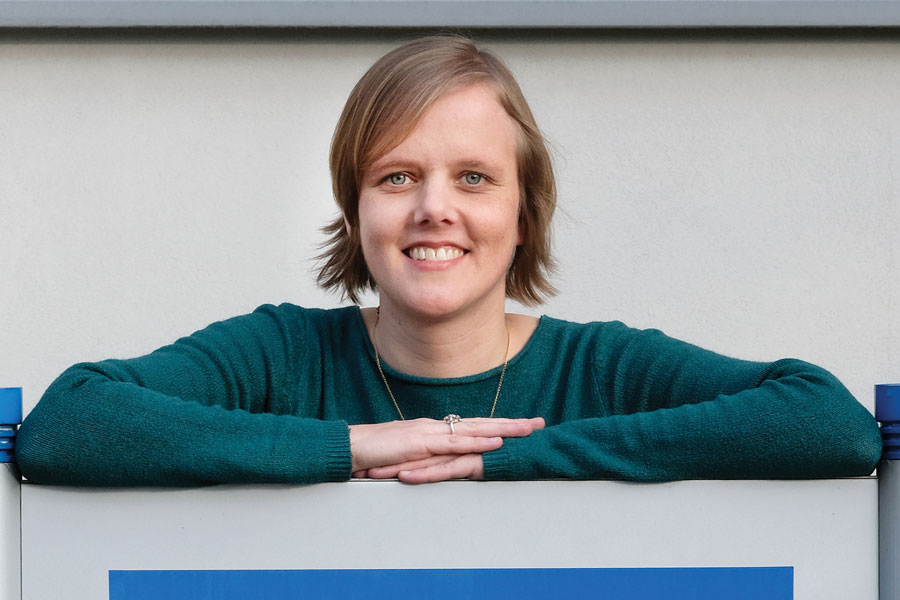Young leader with interdisciplinary aspirations
In 2015, Marion Silies went from Stanford to Göttingen on an Emmy Noether scholarship. The Bernstein Center for Computational Neuroscience Göttingen was a big pull factor for her decision. Today, she is professor for neurobiology at the University of Mainz.

Marion Silies, © ENI, Göttingen
/BN, C. Duppé/ Marion Silies‘ CV is impressive. Brimming with awards, grants and a postdoc position at Stanford University in the USA, her career seems to advance with the greatest of ease. When talking to her, one realizes quickly that the young neuroscientist is characterized by clarity, determination and responsibility. Her decisions point the way not only for her personal scientific career, but also for the field of science in which she is active and, last but not least, for the young people she educates. She chose to establish her Independent Emmy Noether Research Group in Göttingen. Why there?
Being an experimental neuroscientist herself, Silies was attracted to Göttingen because of the strong presence of theoretical neuroscience as it is at the crossroads of theory and experiment where she feels most comfortable. She values the proximity to theoretical neuroscientists who cast a different perspective on her work. “Complementary perspectives enrich my research immensely,” she explains. Göttingen offered her the interdisciplinary environment through the University, the University Medical Center, Max Planck Institutes and not least the Bernstein Center for Computational Neuroscience (BCCN) Göttingen.
All these institutions are represented in the Göttingen Graduate Center for Neurosciences, Biophysics, and Molecular Biosciences, one of those meeting places for young students in which Silies sees great opportunities for modern science. In her opinion, it is precisely this exchange on student level that brings new knowledge, skills and ideas to her group. In Göttingen, Silies was able to intensify her research and break new scientific ground. The local interdisciplinary environment may well be the cause for her “excellent sense for cross-disciplinary questions in neurobiology”.1 This intuition is also evident in scientific initiatives, such as the Priority Program “Evolutionary Optimization of Neuronal Processing”, which was approved by the DFG only recently. Together with Fred Wolf, the head of BCCN Göttingen, Silies initiated the program, which is the first coordinated research program worldwide that combines systemic and theoretical neuroscience with evolutionary and developmental biology to discover basic principles of brain evolution.
From a scientific point of view, Silies has focused on the neural basis of vision from early on. Her favoured model organism, the fruit fly Drosphila melanogaster, might not be exceptional per se but Silies’ research results reveal her strong interdisciplinary focus. To put it simply, she investigates how neural circuits are set up in the brain of the fly and how neurons communicate with each other to process visual information. During her time at Stanford, Silies developed a genetic ‘tool kit’ to manipulate the neural function of specific cells in order to identify the neuronal networks of movement perception. It is being used by numerous laboratories worldwide.2
Since 2015 Silies is leading the Emmy Noether Independent Junior Research Group “Visual Processing” at the European Neuroscience Institute ENI at the University Medical Center Göttingen. Through her novel approach, she has succeeded in making significant contributions in a multi-faceted field of research. This gained her many awards. In 2016, she received an ERC Starting Grant for her project „MicroCyFly“. In 2017 she was awarded the Heinz Maier-Leibnitz Prize of the German Research Foundation.
Marion Silies is quite baffled as to the ease with which things fall into place since a new challenge is already calling for her. She was appointed Professor of Molecular Developmental Neurobiology at University of Mainz. This is why she will leave Göttingen at the beginning of 2019, albeit with mixed feelings being both excited and a little sad to leave. Her farewell is alleviated by the spirit of opportunity awaiting her in Mainz as the university has appointed numerous young professors, which gives co-operative researchers like Silies a lot of room for (co-)designing the future research landscape in Mainz. The members of her group will move with her; this will allow the „work to continue (almost) seamlessly.” The vicinity to the Bernstein colleagues in Frankfurt a. M. will further facilitate the work on joint projects. By moving to Mainz, Silies expands the Bernstein Network by another hotspot in the Rhine-Main area.
Marion Silies meets the new challenge with much respect – not only in a scientific sense. For her, it is the next step on the career ladder but also another step towards becoming a role model as a female leader in science. Ever since she is leading a group, she has been aware of the importance of role models, in particular for women in science. She therefore wants to encourage young women to not question their abilities, because “naturally, women can do good science, too!” Silies hopes that women in scientific leadership positions will become the norm, a wish she does not stand alone with and which she will give a face to.
Published in the Bernstein Feature. 2018. Next Gen/d/eration Computational Neuroscience, pp .20-23.
References
1 Deutsche Forschungsgemeinschaft. „Verleihung des Heinz-Maier-Leibnitz-Preises 2016. Laudatio auf die Preisträgerin Dr. Marion Silies.“ Bonn, Mai 2017. http://www.dfg.de/gefoerderte_projekte/wissenschaftliche_preise/leibnitz-preis/2017/silies/index.html
2 Deutsche Forschungsgemeinschaft. “Marion Silies – Heinz Maier-Leibnitz-Preisträgerin 2017” http://www.dfg.de/gefoerderte_projekte/wissenschaftliche_preise/leibnitz-preis/2017/silies/index.html




